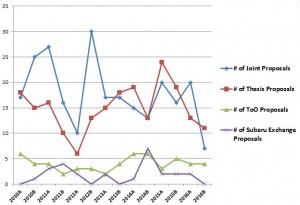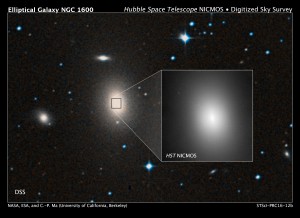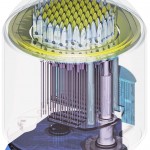By/par Stéphanie Côté (NRC Herzberg)
(Cassiopeia – Summer/été 2016)
Some Stats About Semester 2016B
After a record crop of proposals last semester 2016A (the total number of hours requested was one of our largest demand in Canadian Gemini history), a more modest, although still healthy, request for Gemini time was received for semester 2016B. Gemini-South was slightly more oversubscribed at 1.65, than Gemini-North at 1.53 (using the ratio of requested time over the amount of time available in Band 1 and 2 to Canada; Band 1 + Band 2 hours correspond to the number of hours actually observed for Canadian programs each semester, while Band 3 is overfilling the queue).
As usual, up to close to 40% of the proposals were for MSc/PhD students’ theses this semester. Only a handful of ToO proposals were received (2 rapid and 2 standards). No Subaru Exchange proposals were received this semester, although this is not unusual.

Figure 2 – Number of Joint, Thesis, ToO and Subaru Exchange proposals received in the last semesters.
For Semester 2016B, more proposals were received for GRACES (high-resolution spectroscopy) than for any other instruments including GMOS-N and GMOS-S. This is very rare and has only happened once before that an instrument is more popular than either GMOS (Flamingos2 managed this feat once, a few semesters ago). Note that the GRACES proposals are all for galactic work so far, even though its excellent throughput would allow to venture to extragalactic targets. On Gemini-South more proposals were received for GMOS-S and Flamingos2. On the pie chart (Figure 3) of % of time requested for each instrument Phoenix (near-IR high-resolution spectroscopy) is prominent, however this is due to a single large proposal that requested 30% of the G-South time.

Figure 3 – Pie charts of the percentages of time requested by each instrument, on Gemini-North (left) and Gemini-South (right).
News on Data Reduction Cookbooks!
GMOS users will be happy to know that the long-awaited “GMOS Data Reduction Cookbook” is now available! It is available here. It was written by Dick Shaw, from the US NGO, including input from the CGO. It covers everything from getting started in iraf/pyraf to processing all GMOS modes including Nod-&-Shuffle and IFU. It is easy to follow, with detailed iraf commands at each step. It also lists excellent on-line resources that could be helpful. Please make sure to check it out and send us your comments, or additions.
The next cookbook in the works will be for GSOAI/GeMs. In the meantime users can check out the excellent tutorials that were presented as a mini-AO workshop at the January AAS in Florida to help neophytes wishing to carry out AO programs. In particular check out the presentation from Tim Davidge on “AO 101: Setting up and characterizing observations of resolved stellar systems”, available here. There is also an excellent presentation covering the AO basics by Claire Max (University of California at Santa Cruz) on “Adaptive Optics for Astronomers: The Basics”, available here, and a more advanced tutorial by Franck Marchis (SETI Institute) on “Processing and Data Analysis With AO instruments: Challenges and Perspectives”, available here.
Recent Canadian Press Releases
- In March 2016 was announced the discovery of the highest velocity C IV broad absorption line seen to date, in the z = 2.47 quasar SDSS J023011.28+005913.6. This was led by Jesse Rogerson (York University) as part of his thesis with supervisor Patrick Hall (York University), and including co-Is Paola Hildago & Patrik Pirkola (York University). About a quarter of quasars exhibit blueshifted broad absorption troughs at ultraviolet wavelengths. These features are a result of material lifted off the accretion disc surrounding the central supermassive black hole and blown away by the quasar radiation, driving the winds to high velocities which are observed as blueshifted absorption. The team sifted through SDSS spectra to select the best 100 new outflows from quasars to follow with GMOS. They discovered this outflow clocking at ∼60 000 km/s, the fastest ever seen. These high velocities outflows will help constrain theoretical acceleration models. The full press release is available here and the full paper is here.
- In April 2016 a team led by Jens Thomas (MPIE) including co-Is Nicholas McConnell and John Blakeslee (NRC Herzberg) announced the discovery of one of the most supermassive black holes ever detected (weighing 17 billion suns), residing in an unlikely place. The biggest SMBHs have been found at the cores of very large galaxies in the dense central regions of rich clusters. This black hole, however, lives in a rather isolated galaxy, NGC1600, lying in a cosmic backwater town (a small group of galaxies). The authors speculate that NGC1600’s black hole might have grown by cannibalizing its former neighboring galaxies and their central black holes in its youth. This research was published in Nature and the press release is available here.
- In April 2016 was also announced the discovery of an especially young, free-floating planet-like analogue to Jupiter in our neighborhood (92 light-years away). Kendra Kellogg and her supervisor Stanimir Metchev (Western University) used Flamingos2 to confirm that 2MASS J1119–1137 is a young object of only about 10 million years, with a mass estimate to be between 4.3 and 7.6 MJup. It is the lowest-mass and nearest isolated member of TW Hydrae at a kinematic distance of 28.9 +/- 3.6 pc, and the second-brightest isolated <10 MJup object discovered to date. The full press release can be found here. This is the first Canadian paper coming out of the Fast-Turnaround program.

Figure 4 – Three GMOS spectra obtained at different times of the z =2.47 quasar J0230 show the variability of the absorption features, especially the CIV near rest-frame wavelength 1550Å. (Figure 4 of “Multi-epoch observations of extremely high-velocity emergent broad absorption”, Rogerson, Hall, Hidalgo et al, MNRAS, 457, 405).

Figure 5 – DSS Image of NGC1600 , a massive elliptical galaxy, residing in a small group of galaxies; with a close-up view of the galaxy shown in the inset image, which was taken with HST/NICMOS. At the heart of NGC 1600 lurks one of the most massive black holes ever detected, weighing 17 billion suns.(Credit: NASA, ESA, and C.-P. Ma (UC Berkeley).
Quelques stats du semestre 2016B
Après une récolte record de demandes reçues le semestre dernier en 2016A (le nombre total d’heures demandées a été un des plus impressionnant de toute l’histoire de Gemini au Canada), une récolte plus modeste, bien que toujours adéquate, de demandes Gemini a été reçu pour ce semestre 2016B. Gemini-Sud a été un peu plus sursouscrit à 1.65, comparé à Gemini-Nord à 1.53 (en utilisant le rapport entre le temps demandé sur la quantité de temps disponible dans les Bandes 1 et 2 au Canada; les heures disponibles dans les Bandes 1 + 2 correspondent au nombre d’heures effectivement observées pour les programmes canadiens chaque semestre, tandis que Bande 3 est un surremplissage de la queue).
Comme d’habitude, jusqu’à près de 40% des demandes ce semestre ont été pour des thèses d`étudiants MSc / PhD. Seule une poignée de demandes ToO ont été reçues (2 rapides et 2 standards). Aucune demande d’échange avec Subaru n`a été reçue ce semestre, ce qui arrive à l`occasion et n`est pas anormal.

Figure 2 – Nombre de demandes jointes, pour thèse, ToO et d`échange avec Subaru reçues dans les derniers semestres.
Pour le semestre 2016B, plus de demandes ont été reçues pour GRACES (spectroscopie à haute résolution) que pour tout autre instrument, y compris GMOS-N et GMOS-S. Ceci est très rare et ce n`est arrivé qu`une seule fois auparavant qu’un instrument soit plus populaire que GMOS (Flamingos2 a réussi cet exploit une fois, il y a quelques semestres). Notez que les demandes de GRACES sont toutes pour des études galactiques jusqu’à présent, même si son excellente transmission permettrait de s’aventurer vers des cibles extragalactiques. À Gemini-Sud ce sont GMOS-S et Flamingos2 qui ont reçus le plus grand nombre de demandes. Sur le graphique de la Figure 3 qui montre le temps demandé pour chaque instrument, Phoenix (spectroscopie à haute résolution dans le proche-IR) prend une grande place, mais cela est entièrement dû à une seule grande demande qui a demandé 30% du temps offert à G-Sud.

Figure 3 – Camemberts des pourcentages de temps demandés pour chaque instrument, à Gemini-Nord (à gauche) et Gemini-Sud (à droite).
Nouvelles sur les manuels de réduction de données!
Les utilisateurs GMOS seront heureux de savoir que le très attendu “GMOS Data Reduction Cookbook” est maintenant disponible! Il est disponible ici. Il a été écrit par Dick Shaw, de l’ONG américain, incluant des ajouts du CGO. Il couvre tout, de comment démarrer dans iraf / pyraf jusqu`au traitement de chacun des modes de GMOS, y compris Nod & Shuffle et l`Unité Intégral de Champ. Il est facile à suivre, avec des commandes IRAF détaillées à chaque étape. Il énumère également d’excellentes ressources en ligne qui pourraient être utiles. S’il vous plaît assurez-vous d`y jeter un coup d`oeil et de nous envoyer vos commentaires ou ajouts.
Le prochain manuel, encore en chantier, sera pour GSOAI / GeMs. En attendant les utilisateurs peuvent vérifier les excellents tutoriels qui ont été présentés lors d`un mini-atelier OA au AAS de janvier en Floride pour aider les néophytes qui souhaitent poursuivre des programmes OA. En particulier veuillez consulter la présentation de Tim Davidge sur “AO 101: Setting up and characterizing observations of resolved stellar systems”, ici. Il y a aussi une excellente présentation couvrant les bases de l`OA par Claire Max (Université de Californie à Santa Cruz) sur “Adaptive Optics for Astronomers: The Basics”, ici, et un tutoriel plus avancé par Franck Marchis (SETI Institute) sur ” Processing and Data Analysis With AO instruments: Challenges and Perspectives”, ici.
Récents Communiqués de presse canadiens
- En Mars 2016 a été annoncée la découverte de la raie d’absorption large de CIV de la plus haute vitesse vue à ce jour, dans le quasar SDSS J023011.28 + 005.913.6 à z=2.47. L`étude a été dirigée par Jesse Rogerson (Université York) dans le cadre de sa thèse avec son superviseur Patrick Hall (Université York), incluant les co-Is Paola Hildago & Patrik Pirkola (Université York). Environ un quart des quasars présentent de larges raies d`absorption décalées vers le bleu à des longueurs d’onde ultraviolettes. Ces caractéristiques sont le résultat de matériaux soulevés en-dehors du disque d’accrétion qui entoure le trou noir supermassif central et emportés au loin par le rayonnement du quasar, entraînant des vents à des vitesses élevées qui sont observées en absorption décalées vers le bleu. L’équipe a passé au crible des spectres SDSS pour sélectionner les 100 meilleurs nouveaux vents de quasars à inspecter avec GMOS. Ils ont découvert ce vent de 60 000 km/s, le plus rapide jamais vu. Ces vents de hautes vitesses aideront à contraindre les modèles théoriques d’accélération. Le communiqué de presse complet est disponible ici et l`article complet est ici.
- En Avril 2016 une équipe dirigée par Jens Thomas (MPIE) incluant les co-Is Nicholas McConnell et John Blakeslee (CNRC Herzberg) a annoncé la découverte d’un des trous noirs les plus supermassifs jamais détectés (de la masse de 17 milliards de soleils), résidant dans un endroit inattendu. Les plus grands SMBHs ont été trouvés dans les noyaux de galaxies très massives dans les régions centrales denses d`amas riches. Ce trou noir, cependant, vit dans une galaxie assez isolé, NGC1600, cachée dans un recoin cosmique tranquile (un petit groupe de galaxies). Les auteurs supposent que le trou noir de NGC1600 aurait grossi en cannibalisant ses anciennes galaxies voisines et leurs trous noirs centraux dans sa jeunesse. Cette recherche a été publiée dans Nature et le communiqué de presse est disponible ici.
- En Avril 2016 a été également annoncée la découverte d’un objet de type planétaire analogue à Jupiter et particulièrement jeune, flottant librement, et très proche (à 92 années-lumière). Kendra Kellogg et son superviseur Stanimir Metchev (Université Western) ont utilisé Flamingos2 pour confirmer que 2MASS J1119-1137 est un jeune objet de seulement environ 10 millions d’années, avec une estimation de masse se situant entre 4,3 et 7.6 MJup. Il est l`objet de plus faible masse et le plus proche membre isolé de TW Hydrae à une distance cinématique de 28,9 +/- 3,6 pc, et le deuxième plus brillant objet isolé de masse <10 MJup découvert à ce jour. Le communiqué de presse complet se trouve ici. Ceci est le premier article canadien issu du programme Fast Turnaround.

Figure 4 – TTrois spectres GMOS obtenus à différentes époques du quasar J0230 à z = 2.47 montrent la variabilité des raies d’absorption, en particulier CIV près de la longueur d’onde de 1550A. (Figure 4 de “Multi-epoch observations of extremely high-velocity emergent broad absorption”, Rogerson, Hall, Hidalgo et al, MNRAS, 457, 405).

Figure 5 – Image DSS de NGC1600, une galaxie elliptique massive résidant dans un petit groupe de galaxies; avec une vue rapprochée de la galaxie figurant dans l’image en médaillon, qui a été prise avec HST / NICMOS. Au cœur de NGC 1600 se cache l’un des trous noirs les plus massifs jamais détectés, de la masses de 17 milliards de soleils (Crédit:. NASA, ESA, et C.-P. Ma (UC Berkeley).













